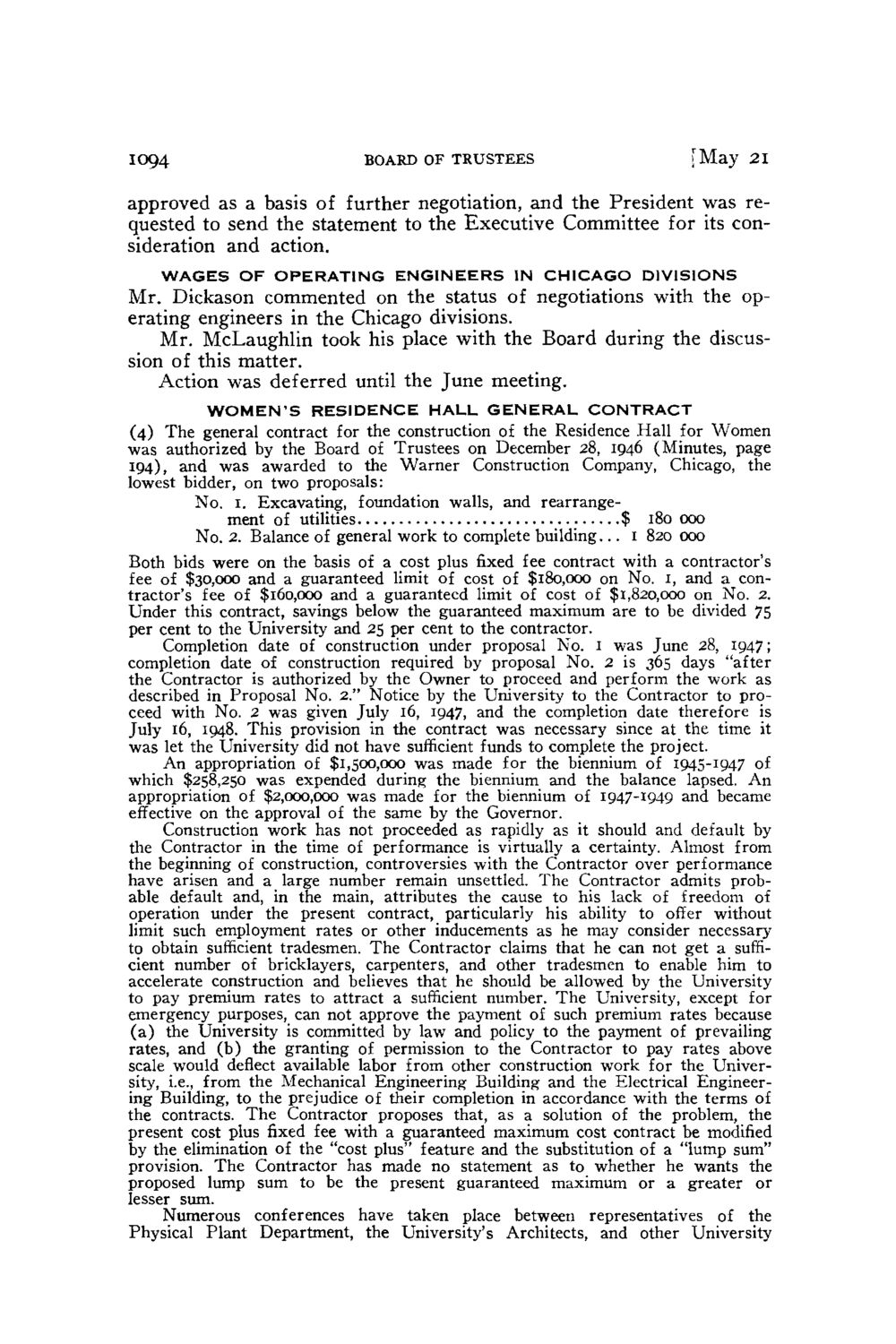| |
| |
Caption: Board of Trustees Minutes - 1948
This is a reduced-resolution page image for fast online browsing.

EXTRACTED TEXT FROM PAGE:
1094 BOARD OF TRUSTEES iMay 21 approved as a basis of further negotiation, and the President was requested to send the statement to the Executive Committee for its consideration and action. WAGES OF OPERATING ENGINEERS IN CHICAGO DIVISIONS Mr. Dickason commented on the status of negotiations with the operating engineers in the Chicago divisions. Mr. McLaughlin took his place with the Board during the discussion of this matter. Action was deferred until the June meeting. W O M E N ' S RESIDENCE HALL GENERAL CONTRACT (4) The general contract for the construction of the Residence Hall for Women was authorized by the Board of Trustees on December 28, 1946 (Minutes, page 194), and was awarded to the Warner Construction Company, Chicago, the lowest bidder, on two proposals: No. 1. Excavating, foundation walls, and rearrangement of utilities $ 180 000 No. 2. Balance of general work to complete building... 1 820 000 Both bids were on the basis of a cost plus fixed fee contract with a contractor's fee of $30,000 and a guaranteed limit of cost of $180,000 on No. 1, and a contractor's fee of $160,000 and a guaranteed limit of cost of $1,820,000 on No. 2. Under this contract, savings below the guaranteed maximum are to be divided 75 per cent to the University and 25 per cent to the contractor. Completion date of construction under proposal No. 1 was June 28, 1947; completion date of construction required by proposal No. 2 is 365 days "after the Contractor is authorized by the Owner to proceed and perform the work as described in Proposal No. 2." Notice by the University to the Contractor to proceed with No. 2 was given July 16, 1947, and the completion date therefore is July 16, 1948. This provision in the contract was necessary since at the time it was let the University did not have sufficient funds to complete the project. An appropriation of $1,500,000 was made for the biennium of 1945-1947 of which $258,250 was expended during the biennium and the balance lapsed. An appropriation of $2,000,000 was made for the biennium of 1947-1949 and became effective on the approval of the same by the Governor. Construction work has not proceeded as rapidly as it should and default by the Contractor in the time of performance is virtually a certainty. Almost from the beginning of construction, controversies with the Contractor over performance have arisen and a large number remain unsettled. The Contractor admits probable default and, in the main, attributes the cause to his lack of freedom of operation under the present contract, particularly his ability to offer without limit such employment rates or other inducements as he may consider necessary to obtain sufficient tradesmen. The Contractor claims that he can not get a sufficient number of bricklayers, carpenters, and other tradesmen to enable him to accelerate construction and believes that he should be allowed by the University to pay premium rates to attract a sufficient number. The University, except for emergency purposes, can not approve the payment of such premium rates because ( a ) the University is committed by law and policy to the payment of prevailing rates, and (b) the granting of permission to the Contractor to pay rates above scale would deflect available labor from other construction work for the University, i.e., from the Mechanical Engineering Building and the Electrical Engineering Building, to the prejudice of their completion in accordance with the terms of the contracts. T h e Contractor proposes that, as a solution of the problem, the present cost plus fixed fee with a guaranteed maximum cost contract be modified by the elimination of the "cost plus" feature and the substitution of a "lump sum" provision. The Contractor has made no statement as to whether he wants the proposed lump sum to be the present guaranteed maximum or a greater or lesser sum. Numerous conferences have taken place between representatives of the Physical Plant Department, the University's Architects, and other University
| |